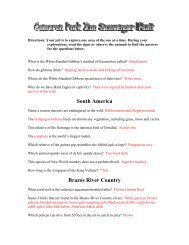New World Vultures vs. Old World Vultures - Cameron Park Zoo
New World Vultures vs. Old World Vultures - Cameron Park Zoo
New World Vultures vs. Old World Vultures - Cameron Park Zoo
You also want an ePaper? Increase the reach of your titles
YUMPU automatically turns print PDFs into web optimized ePapers that Google loves.
used in livestock, but when the livestock die and the vultures feed on their remains, the drug<br />
causes visceral gout and kidney failure in the birds.<br />
Manufacturing of the drug for veterinary use was<br />
outlawed in India in 2006. Unfortunately, the form<br />
manufactured for humans is still produced and is used for<br />
livestock as well. If a way isn’t found soon to protect these<br />
birds, these three species may very well be extinct within<br />
10 years. The clock is running out.<br />
<strong>Vultures</strong> and <strong>Cameron</strong> <strong>Park</strong> <strong>Zoo</strong><br />
There are two vulture species that are native to Texas, and can be seen quite frequently, the<br />
black vulture and the turkey vulture. In the past, there have been up to 300-400 of these<br />
vultures that regularly roost in the trees along the rivers, primarily at the confluence of the<br />
Brazos and Bosque Rivers by <strong>Cameron</strong> <strong>Park</strong> East<br />
In late 2008, renovations began in the park. The noise of the large machinery and earthmovers<br />
disturbed the vultures out of their regular roosting trees. In their search for a quieter place to<br />
roost, the vultures found the perfect place—<strong>Cameron</strong> <strong>Park</strong> <strong>Zoo</strong>. The zoo offered the perfect<br />
place for the vultures, lots of tall trees to roost in at night, plenty of clean water to drink and<br />
bathe in and interesting rocks and perches in various exhibits.<br />
It was a little disconcerting to suddenly have 300+ vultures sitting around the zoo. We are<br />
asked many questions about them, and people thought they were hanging out here because<br />
they were stealing food from our animals, or we had dead animals that they were feeding on.<br />
During the day they search for food and after they feed, they return to the zoo for a safe place<br />
to sleep at night.<br />
We did our best to get along with our new companions, but they spent<br />
a great deal of time on top of one of our buildings and were picking at<br />
the sealing caulk on the roof. We tried a couple of methods to try and<br />
encourage the birds to roost elsewhere. The first was an inflatable<br />
waving arm windsock on the roof. Then we made several effigies, or<br />
fake dead vultures to hang on the roof (the vultures were unimpressed<br />
by our efforts). Finally, the roof had to be repaired and “vulture proofed”.<br />
Now that the construction is nearing completion at the river, many of the<br />
vultures have moved back to their original roosts. There are still quite a<br />
few who have decided that they like it better here at the zoo and are<br />
staying.<br />
After the initial surprise of their sudden appearance in such great<br />
numbers, we have enjoyed observing wild vultures and their behaviors here at <strong>Cameron</strong> <strong>Park</strong><br />
<strong>Zoo</strong>.



